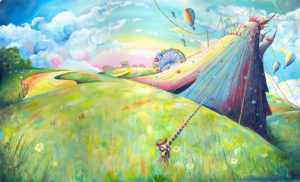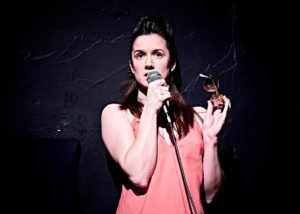
The director of Get the Chance, Guy O’Donnell recently met with Artist Emily Jones. They discussed her training, being named runner-up in the Observer/Cape/Comica graphic short story prize 2017 for graphic short story: Dennis and June and her most recent work for Sherman Theatre, Cardiff.
Hi Emily great to meet you, can you give our readers some background information on yourself please?
Hello, I grew up in Tyneside but I’ve lived in Cardiff for many years now. I studied illustration for children’s books at art college as that’s the branch of illustration I’m really passionate about. Although, I do enjoy drawing cartoons of Donald Trump and other political figures that I find ludicrous! Being an illustrator isn’t my full time job as I prefer the balance of being able to draw and paint when I want, without the worry or pressure of relying on it for an income.

So what got you interested in Illustration?
I had two lovely teachers in primary school and they encouraged me to draw. They made me realise that you could draw pictures for a living. I loved picture books in particular and I had my favourite illustrators who I aspired to be like. I think I’ve always been fascinated with images and how someone has created them.
How has your career as an illustrator developed?
A few years ago, I began renting out an art studio so I had the space to work in a more professional manner rather than just working at home in front of the TV. This really changed things and along with posting my work on social media, I have slowly but surely become busier and better.

Your personalised pet portraits are particularly popular with your work appearing in 1000 Dog Portraits by Rockport Publishers? Can you tell our readers how you got involved in pet portraits? Do you have a favourite animal to illustrate?
I painted my partner’s dog Scooby and it all started from there. I showed the painting to a few people and before long I was being asked to paint their cat or dog. I think painting pets is a great way for any artist to get commissioned as it’s artwork that is really accessible for people to buy. I love painting all sorts of animal but the more animated the creature is, the more fun I find it to be.

Over the last three years you have been commissioned by Sherman Theatre to produce images for the seasonal productions The Princess and The Pea, The Emperor’s New Clothes and this year you have designed the posters for Hud y Crochan Uwd / The Magic Porridge Pot and for the first time the main stage Christmas production The Wind in the Willows . Can you tell us how you approach illustrating such popular classics for the stage?
Well I begin by doing a lot of research on how other artists have illustrated these classic stories. I then do my best to create an image which is original as well as instantly recognisable. The images have to grab attention of both children and adults and hopefully it will make people want to see the show.

The image for Hud Y Crochan Uwd/The Magic Porridge Pot, Sherman Theatre.
Your Wind in the Willows illustration has been developed into an animated trailer this year. Is this a first for you?
Yes it was and it was brilliant to see the image move! The artwork I create for Sherman Theatre is always created in separate layers. This enables the designers to move around the different components to fit whatever format the advert will appear; be it posters, flyers, web-banners etc. Of course, this also enabled the designers to create an animated trailer which is just awesome!
Do you have any illustrators or artists that inspire you?
There are tons! Quentin Blake has always been there as a favourite, as has Edward Gorey. They are experts at depicting characters with seemingly simple pen lines. Shaun Tan’s work is incredible and I wish I had a fraction of his talent! I love Júlia Sardà, David Roberts, Isabelle Arsenault, Alex T. Smith, Michael Sowa, Mateo Dineen, Rebecca Dautremer. They are a just a few! I study their work and try to figure out how they do what they do. They make me feel totally inferior but at the same time, inspire me and enthuse me to create my next best piece; which is definitely a good thing.

Images by Júlia Sardà, Shaun Tan, Edward Gorey and Quinten Blake
Congratulations on being named runner-up in the Observer/Cape/Comica graphic short story prize 2017 for your Graphic short story: Dennis and June. This work is in a digital medium can you discuss how this differs from your painted work?
I recently bought a Huion Graphics tablet so I can draw and colour digitally. It makes illustrating in this comic style so much faster. When I heard about the graphic novel competition, I knew I’d have to create it digitally as painting the way I do, takes so long. Plus, the comic style suits the story much better. Creating digital work has a freedom to it. Mistakes can be easily erased and colouring is instant but physically painting an image will probably always be my favourite way to illustrate.

An image from Dennis and June you can read the full story at the link above
If any of our readers are aspiring illustrators what advice could you offer them?
Draw as often as possible. It seems obvious but you have to practice. Drawing from life is a brilliant way to improve your skills and develop your style. Having a recognisable style is important and it’s something I haven’t mastered yet. But the more work I do, the more I learn and develop. I just wish there was more time in the day to draw!

What do you have planned for the future?
Well, I’ve been having various successes in illustration competitions and I’m hoping this will lead to greater things in the publishing world. I have a couple of children’s books to work on, more images for children’s theatre and when I find the time, I’ll create another graphic story.

You have also designed the images for the 2018 Sherman Theatre Christmas productions Hugan Fach Goch/Little Red Riding Hood and Alice In Wonderland. As a Wales based artist what does the support of Sherman Theatre mean to you personally?
I’ve created images for The Sherman for a while now and it’s always a proud moment seeing my artwork representing their shows. The Sherman has given me huge confidence in regards to my ability as an illustrator and I hope to work with them for years to come.

Image for Hugan Fach Goch/Little Red Riding Hood
Image for Alice in Wonderland
Thanks for your time Emily.
You can check out more or Emily’s work at the link











 (4 / 5)
(4 / 5)



 (5 / 5)
(5 / 5)








 (3 / 5)
(3 / 5)




